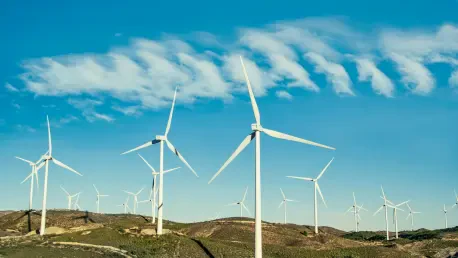Imagine a landscape where towering wind turbines spin with unmatched efficiency, generating enough power to light up tens of thousands of homes while minimizing environmental impact. This vision has become reality in Wittenberg, Saxony-Anhalt, Germany, where a groundbreaking repowering project has transformed an outdated wind farm into a beacon of sustainable innovation. Spearheaded by the VSB Group, this initiative showcases how modern technology can revolutionize renewable energy production, offering a compelling model for the future. By replacing old turbines with fewer but far more powerful units, the project not only boosts output but also addresses longstanding concerns about wind energy. This development signals a pivotal shift in the industry, highlighting the potential for scalability across Europe and beyond. As the world grapples with the urgent need to transition away from fossil fuels, such advancements provide a glimpse into a cleaner, more independent energy landscape that prioritizes both efficiency and environmental harmony.
Advancements in Wind Energy Technology
Harnessing Power with Cutting-Edge Turbines
The transformation at Wind Farm Elster is a testament to the remarkable strides made in wind turbine technology. By dismantling 50 aging turbines and installing just 16 state-of-the-art Siemens Gamesa SG 6.6-155 units, with plans for two more, the project has achieved an astounding 600% increase in efficiency. This upgrade translates to an annual output of 235 gigawatt-hours, a figure substantial enough to supply clean energy to a vast number of households. The significance of this leap cannot be overstated, as it demonstrates how fewer, more advanced turbines can produce exponentially more power. This approach not only maximizes energy generation but also optimizes land use, proving that technological innovation can address the growing demand for renewables without sprawling across vast areas. Such progress underscores the potential for other regions to adopt similar strategies, paving the way for a more sustainable energy grid that meets modern needs with minimal resources.
Reducing Environmental and Community Impact
Beyond raw power output, the repowering effort at Wind Farm Elster tackles some of the most persistent criticisms of wind farms. With fewer turbines in operation, concerns such as noise pollution, risks to wildlife, and visual disruption to scenic landscapes are significantly reduced. Proper siting and advanced design further diminish these issues, showing that environmental and community considerations can be balanced with energy goals. This reduction in turbine count does not compromise performance; instead, it enhances the project’s compatibility with surrounding areas. The emphasis on smarter, more considerate infrastructure reflects a broader trend in the renewable sector to prioritize harmony with nature and local populations. By addressing these drawbacks head-on, the initiative sets a new standard for how wind energy projects can be integrated into diverse environments, ensuring that sustainability extends beyond mere energy production to encompass a holistic respect for ecosystems and human well-being.
Broader Implications for Renewable Energy
Strengthening Energy Sovereignty in Europe
The repowering of Wind Farm Elster carries profound implications for energy independence across Europe. As articulated by leaders at the VSB Group, such projects are crucial for building a resilient power grid free from the volatility of global fossil fuel markets. By leveraging wind as a stable, cost-effective, and inexhaustible resource, regions can reduce reliance on imported energy, thereby enhancing security and predictability in supply. This shift is particularly vital in the context of geopolitical uncertainties and fluctuating prices associated with traditional energy sources. The success of this wind farm serves as a blueprint for other nations striving to fortify their energy autonomy, illustrating how localized, renewable solutions can create a buffer against external economic pressures. It highlights a strategic move toward self-sufficiency, positioning wind energy as a cornerstone of a future where Europe’s power needs are met through innovation and sustainable practices rather than dependency on finite reserves.
Economic Growth and Job Creation Potential
Another compelling aspect of this renewable energy milestone is its economic ripple effect. The wind sector is proving to be a significant driver of job growth, with roles such as wind turbine technicians becoming some of the fastest-expanding occupations in various global markets. In Europe, projects like Wind Farm Elster promise a similar surge in employment opportunities, from manufacturing and installation to maintenance and technical support. This economic boost extends beyond immediate job creation, fostering long-term stability in communities by anchoring local economies to a growing industry. The focus on modern infrastructure also attracts investment, further stimulating regional development. By intertwining environmental goals with economic benefits, the initiative exemplifies how renewable energy can serve as a dual engine for progress, addressing climate challenges while building a robust workforce. This synergy between sustainability and prosperity offers a forward-looking vision for policymakers and industry leaders aiming to replicate such success on a larger scale.
Reflecting on a Sustainable Legacy
Looking back, the repowering of Wind Farm Elster stood as a landmark achievement that reshaped perceptions of what wind energy could accomplish. It proved that with fewer, more advanced turbines, the industry could deliver unprecedented efficiency while addressing environmental and community concerns with finesse. The project’s success in generating 235 gigawatt-hours annually marked a turning point, inspiring similar upgrades across Europe. Moving forward, the focus should shift to scaling these innovations, ensuring that funding and policy support align to accelerate the adoption of cutting-edge technologies. Collaboration between governments, private sectors, and local stakeholders will be essential to replicate this model, prioritizing sites for repowering and integrating community feedback. Additionally, continued investment in workforce training can sustain the economic momentum, equipping future generations with skills for a renewable-driven world. This legacy of innovation and balance offers a clear path toward a cleaner, more secure energy future, urging global leaders to act decisively.









